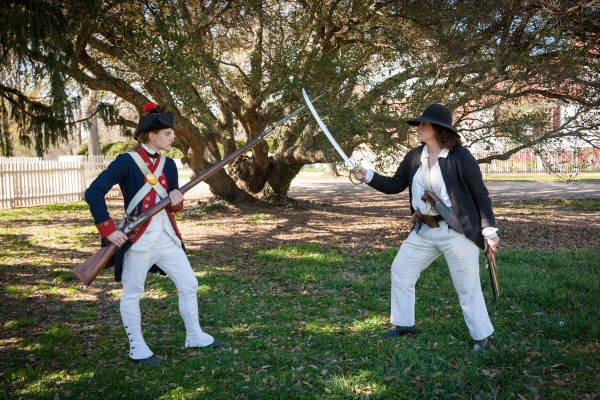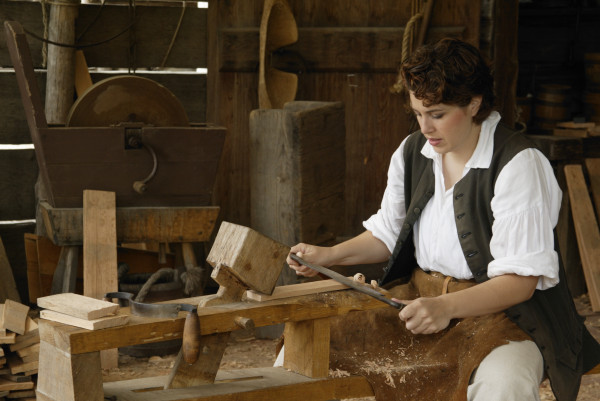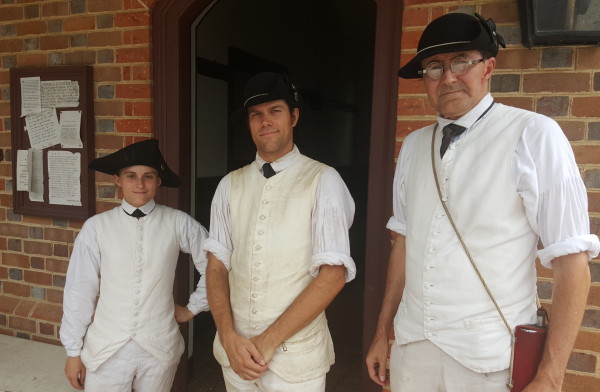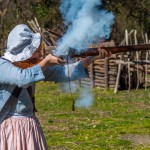
One of the most common questions I’m asked is, “Would a woman be allowed to be a cooper?” In fact, we know of three women who were coopers in Virginia in the 18th century, although none worked in Williamsburg.
My attire is usually the next subject of curiosity, since I dress like a man but am not pretending to be a man. Why, you wonder?
To be honest, we know very little about how female coopers dressed in the 18th century. The records simply don’t tell us what they wore to do their job. There is evidence that a few women, at least, embraced the practicality of male attire, including “Mad Ann” Bailey, who worked as a scout and lived near Staunton, Va.
Others made different adjustments. In 1741, William Hutton was traveling in England when he witnessed “one or more females, stripped of their upper garments, and not overcharged with the lower, wielding the hammer with all the grace of the sex.”
It makes sense, though it would have been a very rare sight. Some of these situations are women who are not pretending to be men, but are just wearing male clothes to get a job done.
Something we tend to forget is that work spaces were private spaces and we would have seen various types of attire or states of undress. Many businesses of the 18th century were small and family operated. Imagine working on your farm in the 18th century, in the middle of July—in the blistering heat—with temperatures nearing triple digits. If there was no one else around, why wouldn’t you wear your shift? But you probably wouldn’t want to be seen that way. It would have been viewed as being as socially unacceptable as wearing male attire.

Imagine the same scenario in a trade shop where sweat is dripping down your face and you are getting paid by the piece. Picture a shop in the dead of winter when it is so cold that the buckets by the fireplace have ice in them instead of water. You would put as many layers on that you could to keep warm to start your day of work. So why not wear your brother’s, father’s, or husband’s clothes if it made the work easier to do and no one but your family was around to see you? Working for a living was not a privilege but a necessity for most. It was not always possible for people of the working and poor sorts to abide by the social restrictions established by the wealthy.
Not all women were ladies. Elizabeth Wilkinson, “the Cockney Champion,” was the first known female boxer, said to be skilled with her fists and other weapons on the streets of London.
Some women were even criminals. Take for instance the infamous pirate Anne Bonny. According to records she did not hide her gender from her fellow shipmates and even donned male attire for battle. She did not shy away from her femininity but used it to her advantage. A handful of women combatants of a different sort went to great lengths to hide their gender.
I’ll let my colleague, Katie, share some of her experiences as a female portraying a male soldier.
A typical day in my life consists of waking up, putting on the uniform of a member of the State Garrison Regiment, interpreting the history of the American Revolution, and demonstrating the tools used to fight it. I answer hundreds of questions daily on a wide variety of topics (everything from bayonets to bathrooms), but one of the most frequent questions I receive in my role is, “Would a woman really have dressed like that and fought like that?”

The short answer is “no.” Women were not allowed to enlist into the British or Continental Army in the 18th century (although scores of women accompanied and aided the army’s efforts). There are very few accounts of women disguising themselves as soldiers in the American Revolution. Of the scarce names we do have, we unfortunately know little about them.
There is one exception, however: a figure partially clouded by myth, she served dressed as a man and in 1802 was the first woman to go on a lecture tour in the United States. Despite her first biographer embellishing her story to the point of dime novel status, there is much we do know about her life. But to understand her story, you must first start with a young soldier named Robert Shurtliffe who served in the Company of Light Infantry of the 4th Massachusetts Regiment.
Although much of the war had ceased after the surrender at Yorktown, Robert got his first taste of battle soon after enlistment fighting bands of Tories. He escaped his first action unscathed but with musket ball holes through his hat and coat. At his second engagement, Robert received his first wounds.
Taken to hospital, Robert sat numb to his pain as a French surgeon cleaned and bound the gash on his head. Unbeknownst to the surgeon, Robert had also been shot. After his visible wound was treated, the surgeon asked Robert if he had any other injuries. Robert replied that if any other wounds appeared, he would inform them; he then proceeded to find a private place to attempt to remove the musket ball in his left thigh with nothing but a probe taken from the hospital, a needle, and a bottle of wine.
Robert could not allow any military surgeon to treat his musket ball wound-and the reason was that his name was not Robert Shurtliff. The young wounded soldier fearing for his life was actually Deborah Sampson.
After serving successfully and bravely for a year and a half, Deborah encountered a foe she could not outwit or defeat: disease. After falling unconscious from fever, her true gender was discovered by the surgeon. After some deliberation she received an honorable discharge from General Knox. Later, her story was recorded (with some exaggerations and modifications) by Herman Mann and her speaking tour spread the story of Robert Shurtliffe far and wide.
It is in her name and the names of all Revolutionary War veterans that I tell the stories of the American Revolution and teach Colonial Williamsburg guests about the life of a common soldier. So if you see me out by the cannons, in the Military Encampment or out on the street, feel free to stop and say hello! But remember, it’s Sergeant Watkins… and the secret stays between us.
Suggested Reading
- Women and Gender in Early Modern Europe, by Merry E. Wiesner. 1993
- The Tradesman’s True Guide or a Universal Directory for the Towns of Birmingham, Wolverhampton, Walsal, Dudley and the manufacturing village in the neighborhood of Birmingham, 1770
- Masquerade: The Life and Times of Deborah Sampson, Continental Soldier, by Alfred Young, 2005
- The Female Review: The Life of Deborah Sampson, by Herman Mann, Boston, 1916
- “Crossdressing, the Theatre, and Gender Struggle in Early Modern England,” by Jean E. Howard, Shakespeare Quarterly, Vol. 39, No. 4. (Winter, 1988), pp. 418-440
GUEST BLOGGER: RAMONA VOGEL
Ramona Vogel has worked at the Colonial Williamsburg Foundation for more than 20 years. Most of that time has been in the trades department. She was inducted as an Honorary Freeman of the City of London by the Worshipful Company of Coopers in Spring of 2004. This was the first time an American and a female had been given this opportunity in the guild. In January of 2008 she became a Journeyman Cooper under the wonderful leadership of Master Cooper James Bernard Pettengell.
Ramona is also the Coordinator of WWOW (Working Women of Williamsburg) which is a wonderful group of women in CWF dedicated to research, educate, and to accurately interpret 18th Century women.
GUEST BLOGGER: KATIE WATKINS
Katie Watkins worked in the field of museum education and Revolutionary War history for eight years before joining the Colonial Williamsburg Foundation as a Military Programs Interpreter in 2014. She began her journey as a middle school volunteer, leading her to become a strong proponent of youth volunteering programs in museums and is thrilled to be living out her dream in one of the most beautiful places in Virginia.
Katie is a 2013 history major graduate of Christopher Newport University, a volunteer judge for National History Day, is working towards completion of a Certificate of Museum Management from the Virginia Association of Museums and is proud mom to the sweetest little greyhound you’ll ever meet. Keep an eye out for her in the Public Magazine or just follow the booms!


Gina says
There was also Anna Maria Lane, who, impersonating a man, fought alongside her husband and got a veteran’s pension after the war for her service. As stated in the article, not a lot more is known about her. I used to serve in CW militia and got this question constantly so I know guests are very curious. Thanks for posting this, especially with suggestions for further reading!
Gina says
There was also Anna Maria Lane, who, impersonating a man, fought alongside her husband and got a veteran’s pension after the war for her service. As stated in the article, not a lot more is known about her. I used to serve in CW militia and got this question constantly so I know guests are very curious. Thanks for posting this, especially with suggestions for further reading!
Melissa says
What a fun article! Thanks for the great read, ladies! And thanks for helping to add ladies back into the narrative of the nitty gritty of daily life in the 18th C.
This is what Colonial Williamsburg is all about ~~~ teaching history. Learned quite a lot from just this article.
At one time I was thinking about re enacting in a Civil War Unit as a soldier, but I couldn’t find one who would accept me! SO my husband and I turned to re enacting Civil War era citizens. That has been lots of fun and we have even included our grand daughter in our presentations.